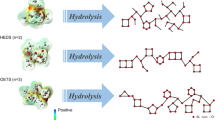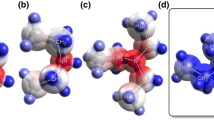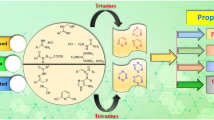Abstract
Octa(3-chloropropylsilsesquioxane), (T-ClPr)8, and a soluble, low molecular weight, poly(3-chloropropylsilsesquioxane) were subjected to a reaction with dimethyl-n-octylamine to convert part or almost all the chloropropyl groups to corresponding quaternary ammonium salt (QAS) groups. Polysilsesquioxanes containing secondary n-amylammonium salt (SAS) groups were synthesized by reaction of n-alkyl bromides with poly(3-aminopropylsilsesquioxane) of limited molecular weight or by amination of n-amyl bromide with 3-aminopropyltriethoxysilane followed by hydrolysis and polycondensation. The antibacterial activity of these QAS- and SAS-containing silsesquioxane materials against two representative Gram-positive and three representative Gram-negative bacterium strains were tested. Most of these materials showed high or moderate activity against Gram-positive bacteria and moderate or weak activity against Gram-negative bacteria.







Similar content being viewed by others
References
Rahn O., Van Eseltine W. (2000). Annu. Rev. Microbiol. 1:173
Franklin T. J., Snow G. A. (1981). Biochemistry of Antibacterial Action. Chapman and Hall Ltd, London
McBain A. J., Ledder R. G., Moore L. E., Catrenich C. E., Gilbert P. (2004). Appl. Environ. Microb. 70:3449
Kanazawa A., Ikeda T., Mendo T. (1993). J. Polym. Sci. Part A, Polymer Chem. 31:1441
Denyer S. P. (1995). Int. Biodeter. Biodegr. 36:227
Kenawy E. R., Abdel-Hay F. I., El-Raheem A., El-Shanshoury R., El-Newehy M. H. (2002). J. Polym. Sci, Part A: Polym. Chem. 40:2384
Ślusarczyk A., Kuczyńska H. (2004). Polimery 49:589
Battice D. R., Hales M. G. (1985). J. Cellular Plastics 5701:332
El Ola S. M. A., Kotek R., White W. C., Reeve J. A., Hauser P., Kim J. H. (2004). Polymer 45:3215
N. Clarkson and L. V. Evans, Biofouling 7, 187 (1993); ibid. 9, 129 (1995).
A. Popa, G. Ilia, S. Iliescu, G. Dehelean, A. Pascariu, A. Bora, and C. M. Davidescu, Mol. Cryst. Liq. Cryst. 418, 923 (2004); A. Popa, C. M. Davidescu, R. Trif, G. Ilia, S. Iliescu, and G. Dehelean, React. Funct. Polym. 55, 151 (2003).
Worley S. D., Sun G. (1996). Trends Polym. Sci. 4:364
Tashiro T. (2001). Macromol. Mater. Eng. 286:63
N. Nurdin, G. Helary, and G. Sauvet, J. Appl. Polym. Sci. 50, 663 (1993); J. Hazziza-Laskar, G. Helary, and G. Sauvet, ibid. 58, 77 (1995).
Kim C. H., Choi K. S. (2002). J. Ind. Eng. Chem. 8:71
Kenawy E. R., Mahmoud Y. A. G. (2003). Macromol. Biosci. 3:107
Dizman B., Elasri M. O., Mathias L. J. (2004). J. Appl. Polym. Sci. 94:635
Kugler R., Bouloussa O., Rondelez F. (2005). Microbiol. 151:1341
Sauvet G., Dupond S., Kaźmierski K., Chojnowski J. (2000). J. Appl. Polym. Sci. 75:1005
Sauvet G., Fortuniak W., Kaźmierski K., Chojnowski J. (2003). J. Polym. Sci., Part A: Polym. Chem. 41:2939
Hardman B., Torkelson A. (1989). in Encyclopedia of Polymer Science and Engineering. In: Mark H. F., Bikales N. M., Overberger C. G., Menges G., Kroschwitz J. I., (eds) 2nd edn., Vol 15. J. Wiley & Sons, New York, pp. 204–308
Dittmar U., Hendan B. J., Flörke U., Marsmann H. C. (1995). J. Organomet. Chem. 489:185
R. Weidner, N. Zellner, B. Deubzner, and V. F. Frey, Schutzrecht DE 383797-A1 (10.5.1990); Wacker-Chemie, Int. Cl. 5: C 07 F 7/08, Chem. Abstr. 113, 116465m (1990).
Rościszewski P., Kazimierczuk R., Sołtysiak J. (2006). Polimery 51(1):3
Andrews J. M. (2001). J. Antimicrob. Chemoth. 48(Suppl. S1):5
Laine R. M. (2005). J. Mater. Chem. 15:3725
Amsterdam D. (1996). In: Loman V. (ed). Antibiotics in Laboratory Medicine, 4th edn. Williams and Wilkins, Baltimore, pp. 52–111
Łukasiak J., Rościszewski P., Jamrógiewicz Z., Dąbrowska-Szponar M., Glinka R., Falkiewicz B. (1999). Pol. J. Cosmet. 3:209
Acknowledgments
The financial support by the Ministry of Education and Science of Republic of Poland, Grant 3 T09 B 06926 is highly appreciated. Authors are indebted to Dr Grzegorz Lapienis for the performing of the SEC analysis in water solution.
Author information
Authors and Affiliations
Corresponding author
Rights and permissions
About this article
Cite this article
Chojnowski, J., Fortuniak, W., Rościszewski, P. et al. Polysilsesquioxanes and Oligosilsesquioxanes Substituted by Alkylammonium Salts as Antibacterial Biocides. J Inorg Organomet Polym 16, 219–230 (2006). https://doi.org/10.1007/s10904-006-9048-5
Published:
Issue Date:
DOI: https://doi.org/10.1007/s10904-006-9048-5




